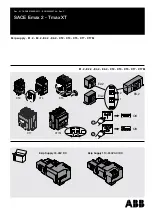
VM1-T
- VACUUM CIRCUIT BREAKER
12
6.4 Movement of the
withdrawable breaker part
(Figures 9/9, 9/16 and 9/20 to
9/22)
Perform switching operations with the front doors
shut.
6.4.1 Manual insertion from the test/
disconnection
position to the service
position
•
Connect control wiring plug 36.1.
•
Close the front door.
•
Ensure that the circuit breaker is in the OFF
position.
•
Fit hand crank 38 on square spigot 35.2 of the
spindle mechanism 35.1.
Note:
In order to avoid damage to the operating
mechanism, use the original hand crank only:
•
Standard version without slip clutch,
•
Optional version with slip clutch.
•
Turn the crank clockwise according the table until
the stop is reached and the withdrawable part 31
is in the service position.
Note:
Do not use force to move the withdrawable breaker
part (Maximum torque 25 Nm!)
Comply with the conditions for movement of the
withdrawable part as set out in section 7.5.4!
Panel type
Number of crank turns
12/17.5 kV
24 kV
UniGear type ZS1
20
30
•
Observe the position indicator in the front door.
•
Remove hand crank 38 by first pressing slightly
against the hand crank and then remove.
Note:
When removing the crank, it is essential to ensure
that the spring-loaded guide 35.6 slides into the
untensioned front position. Spindle 35.1 is thus
locked in place, preventing inadvertent turning of
the spindle. Turning of the spindle opens auxiliary
switches -BT2 / -BT1 and thus prevents the circuit
breaker from being operated.
Note:
The withdrawable part must not be stopped at any
position in the travel range between the service
position and test/disconnected position!
—
6. Commissioning / Operation
6.4.2 Manual withdrawal from the service
position into the test/disconnected
position
•
Ensure that the circuit breaker is in the OFF
position.
•
Reverse the procedure described above for
insertion into the service position.
Note:
Withdrawable parts with blocking magnet -RL2 may
not be forcibly moved during power failures. In such
a case they are blocked in the service and test
positions. For deblocking, see section 7.5.4.
6.4.3 Motor-driven movement of the
withdrawable part
•
Briefly operate the electrical control for insertion
or withdrawal (the withdrawable part then
automatically moves into the opposite position).
•
Observe the position indicator in the front door.
Note:
When the motor fails, the withdrawable part can be
moved in emergency manual operation. If the drive
motor fails during movement of the withdrawable
part, the withdrawable part must be moved into a
limit position in emergency manual operation.
Emergency manual operation:
Emergency manual operation is carried out with the
hand crank 38 on the spindle mechanism 35.1, in a
similar manner to operation of a withdrawable
breaker part with manual systems:
•
Turn off the supply voltage (m.c.b.), since the
motor would otherwise be braked electrically.
•
Turn hand crank 38 in the required direction.
•
When the withdrawable part moves, the motor
turns. The motor functions in such a case like a
generator, i.e. it can lead to reverse voltages in the
terminals.
•
The motor protection device must not be changed
from the specified type and rated value, or the
behaviour of the permanent magnet motor could
be irreversibly impaired.
Summary of Contents for VM1-T
Page 43: ...MEDIUM VOLTAGE PRODUCTS 43 ...




































